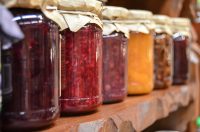by admin | December 30, 2019 8:53 am | Cooking ideas, Diet Tips ( I lost 160 LBS), Health, Main, Success, Well Being
This year has been a bit of a challenge. Starting something new and sticking with it is not always the easiest thing. I have not promoted the web site this year because like all of us I wanted a little content here before I went out Bragging to the world. :-). This is the last Post for 2019 (Happy New Year) next year will be a new challenge with new ideas. Stick with me because a lot of free ebooks and information are coming your way in the next year of my plan.
 9 Healthy Foods That Lift Your Mood
9 Healthy Foods That Lift Your Mood
When you’re feeling down, it can be tempting to turn to food to lift your spirits. However, the sugary, high calorie treats that many people resort to having negative consequences of their own.
Thus, you may wonder whether any healthy foods can improve your mood.
Recently, research on the relationship between nutrition and mental health has been emerging. Yet, it’s important to note that mood can be influenced by many factors, such as stress, environment, poor sleep, genetics, mood disorders, and nutritional deficiencies, Therefore, it’s difficult to accurately determine whether food can raise your spirits.
Nonetheless, certain foods have been shown to improve overall brain health and certain types of mood disorders.
Here are 9 healthy foods that may boost your mood.
Share on Pinterest
- Fatty fish
Omega-3 fatty acids are a group of essential fats that you must obtain through your diet because your body can’t produce them on its own.
Fatty fish like salmon and albacore tuna are rich in two types of omega-3s — docosahexaenoic acid (DHA) and eicosapentaenoic acid (EPA) — that are linked to lower levels of depression Omega-3s contribute to the fluidity of your brain’s cell membrane and appear to play key roles in brain development and cell signaling
While research is mixed, one review of clinical trials showed that in some studies, consuming omega-3’s in the form of fish oil lower depression scores.
Although there’s no standard dose, most experts agree that most adults should get at least 250–500 mg of combined EPA and DHA.
Given that a 3.5-ounce (100-gram) serving of salmon provides 2,260 mg of EPA and DHA, eating this fish a few times per week is a great way to get these fats into your diet.
From these facts, I have determined that fatty fish such as salmon which are rich in omega-e fatty acids, may lower your risk of depression.
- Dark chocolate
Chocolate is rich in many mood-boosting compounds. That’s the best news I’ve had in a long time about food 😉
It’s likely the sugar may be what improves mood since it’s a quick source of fuel for your brain.
Furthermore, it may release a cascade of feel-good compounds, such as caffeine, theobromine, and N-acylethanolamine — a substance chemically similar to cannabinoids that have been linked to improved mood.
However, some experts debate whether chocolate contains enough of these compounds to trigger a psychological response. I choose to absolutely believe this because “I” am a chocolate expert in my own mind.
Nerveless, I want to mention that chocolate is high in health-promoting flavonoids, which have been shown to increase blood flow to your brain, reduce inflammation, and boost brain health all of which may support mood regulation. Chocolate also has a high hedonic rating, meaning that its pleasurable taste, texture, and smell may also promote a good mood.
Because milk chocolate contains added ingredients like sugar and fat, it’s best to opt for the “dark” chocolate which is higher in flavonoids and lower in added sugar. You should still stick to 1–2 small squares (of 70% or more cocoa solids) at a time since it’s a high-calorie food.
Dark chocolate is rich in compounds that may increase feel-good chemicals in your brain. (Ok I vote for this; do we get to vote?)
- Fermented foods
Fermented foods which include kimchi, yogurt, kefir, kombucha, and sauerkraut, may improve gut health and mood. OK, I am going to be honest and up-front about this “I HATE FERMENTED FOODS” I hope you love them. It’s just a thing I have but to me, nothing is as bad as yogurt. I wish I liked it! I see all those people with light easy snacks and getting over a bad stomach thing with their yogurt but it just makes me want to regurgitate.
The fermentation process allows live bacteria to thrive in foods that are then able to convert sugars into alcohol and acids.
During this process, probiotics are created. These live microorganisms support the growth of healthy bacteria in your gut and may increase serotonin levels.
It’s important to note that not all fermented foods are significant sources of probiotics, such as in the case of beer, some breads, and wine, due to cooking and filtering.
Serotonin is a neurotransmitter that affects many facets of human behavior, such as mood, stress response, appetite, and sexual drive. Up to 90% of your body’s serotonin is produced by your gut microbiome or the collection of healthy bacteria in your gut.
In addition, the gut microbiome plays a role in brain health. Research is beginning to show a connection between healthy gut bacteria and lower rates of depression.
Since up to 90% of your body’s serotonin is produced in your gut, a healthy gut may correspond to a good mood. Fermented foods like kimchi, yogurt, kefir, kombucha, and sauerkraut are rich in probiotics that support gut health.
- Bananas
Bananas may help turn a frown upside down.
They’re high in vitamin B6, which helps synthesize feel-good neurotransmitters like dopamine and serotonin.
Furthermore, one large banana (136 grams) provides 16 grams of sugar and 3.5 grams of fiber.
When paired with fiber, sugar is released slowly into your bloodstream, allowing for stable blood sugar levels and better mood control. Blood sugar levels that are too low may lead to irritability and mood swings.
Finally, this ubiquitous tropical fruit, especially when still showing green on the peel, is an excellent source of prebiotics, a type of fiber that helps feed healthy bacteria in your gut. (This is like that yucky orange stuff lot of people drink in the mornings some are pre and some are probiotics. A robust gut microbiome is associated with lower rates of mood disorders.
Bananas are a great source of natural sugar, vitamin B^, a prebiotic fiber, which work together to keep your blood sugar levels and mood stable. What nature won’t do to make us eat right. (Or is that di do?)
- Oats
Oats are a whole grain that can keep you in good spirits all morning. You can enjoy them in many forms, such as overnight oats, oatmeal, muesli, and granola.
They’re an excellent source of fiber, providing 8 grams in a single raw cup (81 grams).
Fiber helps slow your digestion of carbs, allowing for a gradual release of sugar into the bloodstream to keep your energy levels stable.
In one study, those who ate 1.5–6 grams of fiber at breakfast reported better mood and energy levels. This was attributed to more stable blood sugar levels, which is important for controlling mood swings and irritability.
Although other sources of whole grains can have this effect, oats may be especially advantageous, as they’re also a great source of iron, with 1 raw cup (81 grams) boasting 19% of your daily needs.
Iron deficiency anemia, one of the most common Nutrient deficiencies and is associated with low iron intake. Its symptoms include fatigue, sluggishness, and mood disorders.
Some research suggests that people experience improvements in these symptoms after eating iron-rich foods or supplementing with iron, but more research is needed.
- Berries
Curiously, eating more fruits and vegetables is linked to lower rates of depression.
Although the mechanism isn’t clear, a diet rich in antioxidants may help manage inflammation associated with depression and other mood disorders.
Berries pack a wide range of antioxidants and phenolic compounds, which play a key role in combatting oxidative stress — an imbalance of harmful compounds in your body.
They’re particularly high in anthocyanins, a pigment that gives certain berries their purple-blue-color. One study associated a diet rich in anthocyanins with a 39% lower risk of depression symptoms.
If you can’t find them fresh, try buying frozen berries — which are frozen at their peak ripeness to retain the maximum amount of antioxidants.
- Nuts and seeds
Nuts and seeds are high in plant-based proteins, healthy fats, and fiber.
Additionally, they provide tryptophan, an amino acid responsible for producing mood-boosting serotonin. Almonds, cashews, peanuts, and walnuts, as well as pumpkin, sesame, and sunflower seeds, are excellent sources.
Moreover, nuts and seeds are a large component of both the MIND and Mediterranean diets, which may support a healthy brain. Each of these diets promotes fresh, whole foods and limits your intake of processed items.
What’s more, a 10-year study in 15,980 people linked moderate nut intake to a 23% lower risk of depression (FYI, I LOVE nuts, both the people and the food kind).
Finally, certain nuts and seeds, such as Brazil nuts, almonds, and pine nuts, are good sources of zinc and selenium. Deficiency in these minerals, which are important for brain function, is associated with higher rates of depression — although more research is needed.
- Coffee
Coffee is the world’s most popular drink, and it may make the world a bit happier, too.
The caffeine in coffee (tea) prevents a naturally occurring compound called adenosine from attaching to brain receptors that promote tiredness, therefore increasing alertness and attention.
Moreover, it increases the release of mood-boosting neurotransmitters, such as dopamine and norepinephrine.
A study in 72 people found that both caffeinated and decaffeinated coffee and tea significantly improved mood compared with a placebo beverage, suggesting that coffee contains other compounds that influence mood.
Researchers attributed this boost in attitude to various phenolic compounds, such as chlorogenic acid. Still, more research is needed.
Everyone here gets tired of me saying “ill just make some teas, tea fixes everything. Looks Like I was correct 😉
- Beans and lentils
In addition to being high in fiber and plant-based protein, beans, and lentils, are full of feel-good nutrients.
They’re an excellent source of B vitamins, which help improve mood by increasing levels of neurotransmitters like serotonin, dopamine, norepinephrine, and gamma-aminobutyric acid (GABA), all of which are important for regulating mood.
Furthermore, B—vitamins play a key role in nerve signaling, which allows proper communication between nerve cells. Low levels of these vitamins, especially B12 and folate, have been linked to mood disorders, such as depression.
Finally, they’re a good source of zinc, magnesium, selenium, and non-heme iron, which may likewise elevate your spirits.
The bottom line
When feeling blue, you may crave calorie-rich, high sugar foods like ice cream or cookies to try to lift your spirits.
While this might give you a sugar rush, it’s unlikely to help you in the long term — and may have negative consequences as well.
Instead, you should aim for wholesome foods that have been shown to not only boost your mood but also your overall health. Try out some of the foods above to kick-start your positivity routine.
by admin | August 5, 2019 3:24 pm | Diet Tips ( I lost 160 LBS), Health, Main
Do you find food to be your only source of happiness? How’s it working out for you?
Chances are, not very good. However, you’re not alone; millions of people around the world suffer from food addiction. Food addiction has nothing to do with being greedy, as some people may wrongfully assume; but rather a psychological condition that binds to food.
So is there any way out? Yes, absolutely. You can and should start implementing the tips below to find happiness in the real things in life, and not be held prisoner by food any longer!
Get In Your Workouts
Exercise is so much more important than making you look good. The health benefits are far superior, with looking good coming as a pleasant bonus. Activity promotes the production of feel-good brain chemicals, known as endorphins, which boost mood, productivity, and sense of wellbeing. Repetition is a very important adjuvant in treating depressive illness, and may in some cases be the primary management technique.
For best results, get in your exercise sessions at least three times per week, up to a maximum of 5 times weekly. You will be surprised how good you feel after six short weeks of starting a new plan.
Re-acquaint Yourself With Nature
When is the last time you spend real time in nature? Living in a concrete jungle, we spend less and less time camping, hiking or just going for walks in the beautiful forests. Mind you, we’re not advocating you get lost in unfamiliar territory, but a light step in nature is sure to give you a deeper appreciation of the beauty in the world.
Better yet, how about picking up gardening? Knowing that you nurtured something from a seedling and watched it grow every day can give you joy like raising a child. Knowing that you made a difference in the world may be all you need to break the psychological addiction to food.
Go Out With Friends
We know, sometimes you end up sacrificing friends for food, the selfish master that leads you down a spiral of depression. However, there is always time. Reconnect with friends you haven’t spoken to in week, months or even years.
You will be amazed at how time flies when you’re out with your friends, and you won’t be held captive by food. Also, you are likely to burn a few more calories than you would if you were just at home, and the memories you form from your adventures will give you pleasure for a long time to come. Not the short bouts of up, followed by severing downs that food is notorious for doing.
Practice Meditation
Meditation is no longer some obscure practice followed by just a few but has spread to the mainstream population thanks to its proven benefits on health. Though the addiction to food is a real psychological condition, meditation can help you break the bonds by increasing your appreciation for other things in life, bringing profound happiness. Mindfulness rises, and you experience pleasure and thankfulness for everything in your life.
Get A Pet
A pet can deliver tons of happiness in your life, motivating you to break free from using food as your motivation. Having someone (yes, your pet) that loves you infinitely is a powerful motivator of happiness, and works in most cases. Adopt a puppy or kitten, and you will have tons of fun and pleasure for years to come.
Conclusion
Food needs to resume its real function, being used for fuel and subtle pleasure. It was not meant to become a source of happiness, and this may have been inadvertently promoted due to the marketing of sugary junk.
Go live in the real world, and find your true happiness.
 My former neighbor, Mary Young, a relatively new empty-nester, remarked on how free she feels with her nine kids out of the house. This feeling is common. Joy Smith, author of “,” encourages people to take advantage of it: “For the first time in years, you can cook because you want to, not because you must. You have fewer people and palates to please, so cook in ways you’ve never dared.”
My former neighbor, Mary Young, a relatively new empty-nester, remarked on how free she feels with her nine kids out of the house. This feeling is common. Joy Smith, author of “,” encourages people to take advantage of it: “For the first time in years, you can cook because you want to, not because you must. You have fewer people and palates to please, so cook in ways you’ve never dared.”

Recent Comments